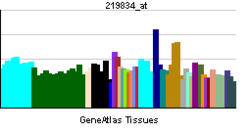ALS2CR8
| View/Edit Human | View/Edit Mouse |
Amyotrophic lateral sclerosis 2 chromosomal region candidate gene 8 protein also known as calcium-response factor (CaRF) is a protein that in humans is encoded by the ALS2CR8 gene.[3][4]
Knocking out the Carf (Als2cr8) gene in mice results in learning associated deficits. Furthermore, Carf has been shown to function as a transcription factor that regulates the expression of BDNF.[5]
References
- ↑ "Human PubMed Reference:".
- ↑ "Mouse PubMed Reference:".
- ↑ Hadano S, Hand CK, Osuga H, Yanagisawa Y, Otomo A, Devon RS, Miyamoto N, Showguchi-Miyata J, Okada Y, Singaraja R, Figlewicz DA, Kwiatkowski T, Hosler BA, Sagie T, Skaug J, Nasir J, Brown RH Jr, Scherer SW, Rouleau GA, Hayden MR, Ikeda JE (Oct 2001). "A gene encoding a putative GTPase regulator is mutated in familial amyotrophic lateral sclerosis 2". Nat Genet. 29 (2): 166–73. doi:10.1038/ng1001-166. PMID 11586298.
- ↑ "Entrez Gene: ALS2CR8 amyotrophic lateral sclerosis 2 (juvenile) chromosome region, candidate 8".
- ↑ Tao X, West AE, Chen WG, Corfas G, Greenberg ME (January 2002). "A calcium-responsive transcription factor, CaRF, that regulates neuronal activity-dependent expression of BDNF". Neuron. 33 (3): 383–95. doi:10.1016/S0896-6273(01)00561-X. PMID 11832226.
Further reading
- Maruyama K, Sugano S (1994). "Oligo-capping: a simple method to replace the cap structure of eukaryotic mRNAs with oligoribonucleotides.". Gene. 138 (1–2): 171–4. doi:10.1016/0378-1119(94)90802-8. PMID 8125298.
- Suzuki Y, Yoshitomo-Nakagawa K, Maruyama K, et al. (1997). "Construction and characterization of a full length-enriched and a 5'-end-enriched cDNA library". Gene. 200 (1–2): 149–56. doi:10.1016/S0378-1119(97)00411-3. PMID 9373149.
- Tao X, West AE, Chen WG, et al. (2002). "A calcium-responsive transcription factor, CaRF, that regulates neuronal activity-dependent expression of BDNF". Neuron. 33 (3): 383–95. doi:10.1016/S0896-6273(01)00561-X. PMID 11832226.
- Hasan MK, Yaguchi T, Sugihara T, et al. (2002). "CARF is a novel protein that cooperates with mouse p19ARF (human p14ARF) in activating p53". J. Biol. Chem. 277 (40): 37765–70. doi:10.1074/jbc.M204177200. PMID 12154087.
- Strausberg RL, Feingold EA, Grouse LH, et al. (2003). "Generation and initial analysis of more than 15,000 full-length human and mouse cDNA sequences". Proc. Natl. Acad. Sci. U.S.A. 99 (26): 16899–903. doi:10.1073/pnas.242603899. PMC 139241
 . PMID 12477932.
. PMID 12477932. - Ota T, Suzuki Y, Nishikawa T, et al. (2004). "Complete sequencing and characterization of 21,243 full-length human cDNAs". Nat. Genet. 36 (1): 40–5. doi:10.1038/ng1285. PMID 14702039.
- Gerhard DS, Wagner L, Feingold EA, et al. (2004). "The Status, Quality, and Expansion of the NIH Full-Length cDNA Project: The Mammalian Gene Collection (MGC)". Genome Res. 14 (10B): 2121–7. doi:10.1101/gr.2596504. PMC 528928
 . PMID 15489334.
. PMID 15489334. - Hillier LW, Graves TA, Fulton RS, et al. (2005). "Generation and annotation of the DNA sequences of human chromosomes 2 and 4". Nature. 434 (7034): 724–31. doi:10.1038/nature03466. PMID 15815621.
- Rual JF, Venkatesan K, Hao T, et al. (2005). "Towards a proteome-scale map of the human protein-protein interaction network". Nature. 437 (7062): 1173–8. doi:10.1038/nature04209. PMID 16189514.
- Kimura K, Wakamatsu A, Suzuki Y, et al. (2006). "Diversification of transcriptional modulation: Large-scale identification and characterization of putative alternative promoters of human genes". Genome Res. 16 (1): 55–65. doi:10.1101/gr.4039406. PMC 1356129
 . PMID 16344560.
. PMID 16344560.
This article is issued from Wikipedia - version of the 5/19/2016. The text is available under the Creative Commons Attribution/Share Alike but additional terms may apply for the media files.
